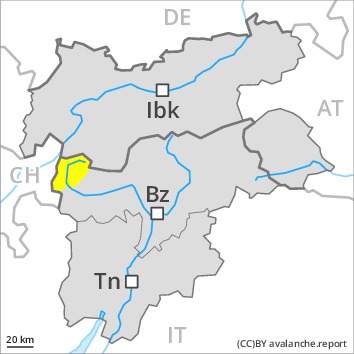
Danger level
Avalanche Problem
 | | Persistent weak layer |
|  | |  |
 | | Wind-drifted snow |
|  | |  |

Old wind slabs are to be evaluated critically.
The wind slabs of the last few days must be evaluated with care and prudence in particular on west to north to east facing aspects above the tree line. In some cases the wind slabs have bonded still only poorly with the old snowpack.
In some places avalanches can be triggered in deep layers of the snowpack and reach large size in isolated cases. This applies in case of releases originating from very steep starting zones at high altitudes and in high Alpine regions that have retained the snow thus far, especially at transitions from a shallow to a deep snowpack. This applies in particular in case of a large load.
Snowpack
These wintry weather conditions gave rise to unfavourable bonding of the snowpack in particular on shady slopes. Faceted weak layers exist deep in the old snowpack especially at high altitudes and in high Alpine regions.
More recent wind slabs have formed in particular in places that are protected from the wind. In some cases the various wind slabs have bonded poorly together. Towards its base, the snowpack is moist. This applies especially at low and intermediate altitudes.
Tendency

Danger level
 | treeline
|
Avalanche Problem
 | | Wind-drifted snow |
|  | |  |
 | | Gliding snow |
|  | |  |

Wind slabs represent the main danger. Individual gliding avalanches can also occur.
The sometimes large wind slabs of last week must be evaluated with care and prudence in particular on west to north to east facing aspects above the tree line. They are in some cases deep and can be released by large loads in particular.
On very steep grassy slopes and on sunny slopes gliding avalanches are possible, even quite large ones. Exposed parts of transportation routes can be endangered occasionally especially in the regions with a lot of snow. Areas with glide cracks are to be avoided.
In isolated cases avalanches can be triggered in deep layers of the snowpack and reach large size in isolated cases. This applies in case of releases originating from very steep starting zones at high altitudes and in high Alpine regions that have retained the snow thus far. Caution is to be exercised in particular at transitions from a shallow to a deep snowpack.
Snowpack
dp.2: gliding snow
dp.6: cold, loose snow and wind
The snowpack will be quite well bonded. More recent wind slabs are to be found in particular in gullies and bowls, and behind abrupt changes in the terrain. In some cases the various wind slabs have bonded poorly together. This applies at high altitudes and in high Alpine regions. Towards its surface, the snowpack is soft and its surface consists of surface hoar. Faceted weak layers exist deep in the old snowpack especially at high altitudes and in high Alpine regions. Towards its base, the snowpack is moist. This applies especially at low and intermediate altitudes.
Tendency
The avalanche danger will persist. Individual gliding avalanches can also be released in the night.













